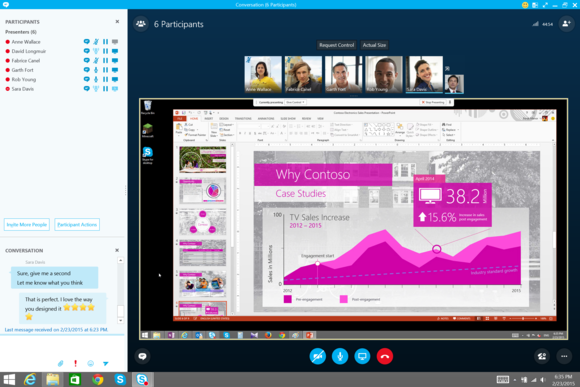Now there are two Skypes for online videoconferencing: the free, consumer version most of us know, and Skype for Business. This rebranded, redesigned Microsoft Lync takes the look and feel of the consumer Skype we all know and applies it to the enterprise.
 Microsoft
Microsoft
Even though the two applications often appear virtually identical now, they are different—and not just because Skype for Business, like Lync before it, costs money. Skype for Business offers capacity and productivity advantages geared for businesses that are big—or that want to look big. For a business with any of the following needs, graduating from free Skype to Skype for Business provides a worthwhile return on investment.
1. You want to have very large meetings
The standard Skype client is currently limited to 25 people on a conference call at once. Skype for Business raises this limit to 250, making it much more suitable for large-scale presentations like all-hands meetings or live webinars. Participants in either Skype or Skype for Business meetings need not be using a Skype client to join the meeting–both services support calls from landlines and standard mobile phones–but extra fees still apply for dial-in users.
2. You want to integrate easily with Office apps
One big draw of Skype for Business is how it’s being integrated into Office 365. Essentially this means you’ll be able to use Outlook directly with Skype for Business’s IM, voice, and video features, clicking directly on a contact to initiate a conversation with them or schedule a meeting for later. Outlook will also archive your Skype for Business meeting history with each contact. Other Office 365 apps get in on the action, too. Want to collaborate on a PowerPoint presentation or Excel spreadsheet on the fly? You’ll be able to initiate a conference and share your screen without having to leave the program.
3. Security and permissions are a concern
Though it doesn’t mean your VoIP calls are bulletproof against eavesdroppers, all Skype traffic (both standard and Skype for Business) is encrypted with AES. Skype for Business raises the stakes with stronger authentication methods that give you, as the administrator, stronger control over accounts and access to the who can do what with the tool. Subscriptions can be added and removed at the user level, with different program features assignable to each user on the service.
4. You want a sophisticated conference room setup
To set up a snazzy dedicated videoconferencing room so, say, two satellite offices can communicate over video with each other, Skype for Business is a much better bet. Lync was built with these types of setups in mind, and the new Skype Room Systems will let you use Skype with standalone cameras and monitors, audio gear from Polycom, and the Microsoft Surface Hub for online whiteboarding via ink or touch. Existing Lync Room Systems can be upgraded to Skype Room Systems. Skype for Business will also be able to integrate with a number of enterprise-class PBX systems, letting you route calls more easily over VOIP using your existing phones.
5. 'Online Plan 2' offers great features for the price
Skype is free, but Skype for Business will cost you. There are two basic plans available for smaller companies. “Online Plan 1” costs $2 per user per month (with a yearly contract) and covers only the basics. Fundamentally you get very little over standard Skype with Online Plan 1, though.
You get significantly more with “Online Plan 2,” a $5.50/month service. It adds high-definition video to group conferences, the ability to join meetings from a web browser (including anonymous connections), desktop sharing and remote control, Outlook schedule integration, the ability to record meetings, and more.
For more sophisticated setups–including conference room integration, E911 support, and dial-in audio features–you’ll need a Skype for Business Server and likely a third-party integrator to do the job. Prices at that level will vary.



0 comments:
Post a Comment